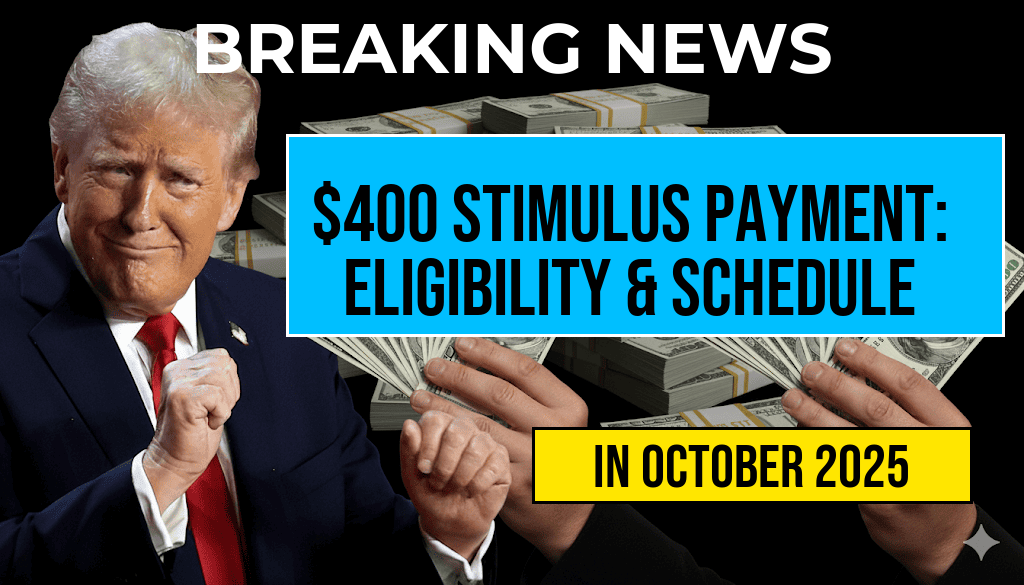A new federal stimulus initiative is offering eligible Americans a $400 payment aimed at providing financial relief amid ongoing economic challenges. This program, which is part of recent government efforts to support households, is accessible to all qualifying individuals regardless of income level. The payment schedule spans several months, with specific eligibility criteria designed to streamline distribution and ensure aid reaches those in need. Details surrounding the application process, eligibility requirements, and the timeline for payments are critical for recipients to understand to maximize benefits. This article provides a comprehensive overview of the $400 stimulus payment, including who qualifies, how to apply, and the complete payment schedule, ensuring clarity for all potential beneficiaries.
Who Is Eligible for the $400 Stimulus Payment?
The stimulus program has been crafted to assist a broad spectrum of Americans, but specific eligibility requirements determine who can claim the $400. Eligibility is primarily based on income, employment status, and whether an individual receives other forms of federal assistance.
General Eligibility Criteria
- Income Limits: Individuals with an annual income below $75,000 or households earning less than $150,000 are eligible.
- Filing Status: The program primarily targets single filers, married couples filing jointly, and heads of households who meet income criteria.
- Residency: Applicants must be U.S. residents or citizens living within the country.
- Tax Filing Requirement: Participants should have filed a federal tax return for the most recent tax year or meet specific criteria outlined by the IRS for non-filers.
Additional Considerations
Individuals receiving other federal benefits such as Social Security, Supplemental Security Income (SSI), or Veterans Affairs (VA) benefits are also eligible without the need to file additional paperwork. Moreover, the program aims to include those who might not traditionally file taxes, ensuring wider reach.
Application Process and How to Claim the Payment
The application process varies based on individual circumstances. Many eligible individuals automatically receive the payment if their information is on record with the IRS or relevant agencies. Others may need to submit an application through designated portals or by filing specific forms.
Automatic Payments
Most recipients who filed taxes in the previous year or receive federal benefits will see the $400 payment deposited directly into their bank accounts. The IRS and associated agencies utilize existing data to expedite distribution, minimizing the need for manual application.
Manual Application Procedures
- Form Submission: Eligible individuals who do not file taxes or have incomplete records should submit a simplified application form available online.
- Application Window: The application period is typically open for a limited time, with specific deadlines announced via official channels.
- Supporting Documentation: Applicants may be required to provide proof of income, residency, or identity to verify eligibility.
Payment Schedule and Distribution Timeline
The distribution of the $400 stimulus payments is scheduled over several months, with phased releases designed to cover all eligible recipients. The payment schedule depends on the applicant’s filing status, method of application, and processing times.
Estimated Payment Dates
| Group | Estimated Payment Date | Method of Distribution |
|---|---|---|
| Automatic recipients (via tax filings or benefits) | First wave: March 15 – March 31 | Direct deposit or mailed check |
| Applicants submitting manual forms | Starting April 10, ongoing | Direct deposit or check upon approval |
Factors Affecting Payment Timing
- Application Completeness: Missing or incorrect information can delay processing.
- Volume of Requests: High application volume may extend processing times.
- Method of Payment: Electronic payments are processed faster than mailed checks.
Additional Resources and Important Links
For further details on eligibility, application procedures, and official updates, individuals are encouraged to consult the IRS website or visit the Congress.gov portal for legislative information. Staying informed through official channels ensures timely access to funds and helps avoid scams or misinformation.
Frequently Asked Questions
Question
Who is eligible to receive the $400 stimulus payment?
Answer
Eligible individuals include taxpayers who meet specific income thresholds and qualify under the criteria set by the government. Generally, recipients must have filed a recent tax return and meet residency requirements.
Question
How can I check the status of my stimulus payment?
Answer
You can check the payment status through the official government portal or payment tracking tool, which provides updates based on your taxpayer information and payment schedule.
Question
What is the payment schedule for the $400 stimulus?
Answer
The complete payment schedule includes specific dates when the stimulus payments will be distributed, typically based on filing status and last digit of your social security number, with many payments issued over several weeks.
Question
Are there any eligibility exclusions for the $400 stimulus payment?
Answer
Yes, certain individuals such as dependents, incarcerated persons, or those with incomes exceeding the specified threshold may be ineligible for the stimulus payment.
Question
What should I do if I did not receive my $400 stimulus payment?
Answer
If you did not receive your payment, you should review your eligibility and contact the appropriate government agency or use the online portal to request a payment trace or resolve any issues.

Leave a Reply